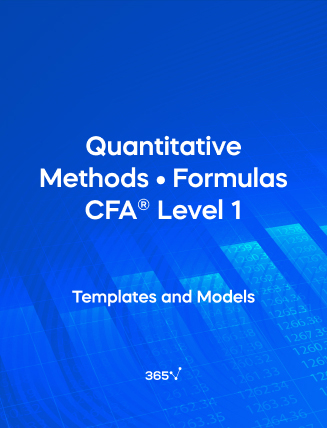Need an all-in-one list with the Quantitative Methods formulas included in the CFA® Level 1 Exam? We have compiled them for you here. The relevant formulas have been organized and presented by chapter. In this section, we will cover the following topics — Time Value of Money, Statistical Concepts and Market Returns, Probability, Distribution, Sampling, Estimation, and Hypothesis Testing.
1. Time Value of Money
Effective Annual Rate (EAR)
Effective~annual~rate = \bigg(1 + \frac {Stated~annual~rate}{m}\bigg)^m- 1Single Cash Flow (simplified formula)
FV{_N} = PV \times (1 + r){^N}PV = \frac {FV{_N}} {(1 + r){^N}}r = interest rate per period
PV = present value of the investment
FV{_N} = future value of the investment N periods from today
Investments paying interest more than once a year
FV{_N} = PV \times \bigg(1+\frac{r{_s}}{m}\bigg){^{mN}}PV = \frac{FV{_N}}{\bigg(1+\frac{r{_s}}{m}\bigg){^{mN}}}r{_s} = Stated annual interest rate
m = Number of compounding periods per year
N = Number of years
Future Value (FV) of an Investment with Continuous Compounding
FV{_N} = PVe^{r_s~N}Ordinary Annuity
FV{_N} = A \times \bigg[ \frac {(1+r){^N-1}}{r} \bigg]PV = A \times \Bigg[ \frac {1-\frac{1}{(1+r){^N}}}{r} \Bigg]N = Number of time periods
A = Annuity amount
r = Interest rate per period
Annuity Due
FV~A{_{Due}} = FV~A{_{Ordinary}} \times (1+r) = A \times \bigg[ \frac {(1+r){^N}-1}{r}\bigg] \times (1+r)PV~A{_{Due}} = PV~A{_{Ordinary}} \times (1+r) = A \times \Bigg[ \frac {1-\frac{1}{(1+r){^N}}}{r} \Bigg] \times (1+r)A = Annuity amount
r = the interest rate per period corresponding to the frequency of annuity payments (for example, annual, quarterly, or monthly)
N = the number of annuity payments
Present Value (PV) of a Perpetuity
PV{_{Perpetuity}} = \frac {A}{r}A = Annuity amount
Future value (FV) of a series of unequal cash flows
FV{_N} = Cash~flow{_1}(1 + r){^1} + Cash~flow{_2}(1 + r){^2} … Cash~flow{_N}(1 + r){^N}Net Present Value (NPV)
NPV=\sum_{t=0}^N \frac{CF_{t}}{(1+r)^t}CF{_t} = Expected net cash flow at time t
N = The investment’s projected life
r = The discount rate or opportunity cost of capital
Internal Rate of Return (IRR)
NPV= CF{_0} + \frac {CF{_1}}{(1+IRR){^1}} + \frac {CF{_2}}{(1+IRR){^2}} + … + \frac {CF{_N}}{(1+IRR){^N}} = 0Holding Period Return (HPR)
No cash flows
HPR = \frac {Ending~value - Beginning~value}{Beginning~value}Holding Period Return (HPR)
Cash flows occur at the end of the period
HPR = \frac {Ending~value - Beginning~value+ Cash~flows~received}{Beginning~value} = \frac {P{_1} - P{_0} + D{_1}}{Beginning~value}P{_1} = Ending Value
P{_0} = Beginning Value
D = Cash flow/dividend received
Yield on a Bank Discount Basis (BDY)
r{_{BD}}= \frac {D}{F} \times \frac {360}{t}r{_{BD}} = Annualized yield on a bank discount basis
D = Dollar discount, which is equal to the difference between the face value of the bill (F) and its purchase price (P{_0})
F = Face value of the T-bill
t = Actual number of days remaining to maturity
Effective Annual Yield (EAY)
EAY = ( 1 + HPR) {^\frac {360}{t}}- 1t = Time until maturity
HPR = Holding Period Return
Money Market Yield (CD Equivalent Yield)
Money~market~yield = HPR \times \bigg(\frac {360}{t}\bigg) = \frac {360 \times r{_{Bank~Discount}}}{360-(t \times r{_{Bank~Discount}})}2. Statistical Concepts and Market Returns
Interval Width
Interval~Width = \frac {Range}{k}Range = Largest observation number – Smallest Observation or number
k = Number of desired intervals
Relative Frequency
Relative~frequency = \frac {Interval~frequency}{Observations~in~data~set}Population Mean
\mu = \frac {\sum_{i=1…n}^Nx{_i}}{N}= \frac {{x{_1}} + {x{_2}} + {x{_3}} + … +{x{_N}}} {N}N = Number of observations in the entire population
x{_i} = the iᵗʰ observation
Sample Mean
\overline x= \frac {\sum_{i=1…n}^nx{_i}}{n} = \frac {{x{_1}} + {x{_2}} + {x{_3}} + … +{x{_n}}} {n}Geometric Mean
G=\sqrt[n]{x{_1}{x{_2}{x{_3}}}…{x{_n}}}n = Number of observations
Harmonic Mean
\overline x{_n}= \frac {n}{\sum_{i=1…n}^n \bigg(\frac{1}{x{_i}}\bigg)}Median for odd numbers
Median= \Bigg\{ \frac {(n+1)}{2} \Bigg\}Median for even numbers
Median= \Bigg\{ \frac {(n+2)}{2} \Bigg\}Median= \frac {n}{2}Weighted Mean
\overline x{_w} = \sum_{i=1…n}^n w{_i}x{_i}w = Weights
x = Observations
Sum of all weights = 1
Portfolio Rate of Return
r{_p} = w{_a}r{_a} + w{_b}r{_b} + w{_c}r{_c} + … + w{_n}r{_n}w = Weights
r = Returns
Position of the Observation at a Given Percentile y
L{_y} = \bigg\{ {(n+1)}\frac{y}{100} \bigg\}y = The percentage point at which we are dividing the distribution
L{_y} = The location (L) of the percentile (Py) in the array sorted in ascending order
Range
Range= Maximum~value - Minimum~value
Mean Absolute Deviation
MAD =\frac {\sum_{i=1…n}^n |X{_i-\overline X}|}{n}x = The sample mean
n = Number of observations in the sample
Population Variance
\sigma{^2} = \frac {\sum_{i=1…n}^n (X{_i-\mu}){^2}}{N}μ = Population mean
N = Size of the population
Population Standard Deviation
\sigma= \sqrt { \frac {\sum_{i=1…n}^N (X{_i-\mu}){^2}}{N}}μ = Population mean
N = Size of the population
Sample Variance
S{^2} = \frac {\sum_{i=1}^n (X{_i-\overline X}){^2}}{n-1}x = Sample mean
n = Number of observations in the sample
Sample Standard Deviation
s = \sqrt { \frac {\sum_{i=1}^n (X{_i-\overline X}){^2}}{n-1}}x = Sample mean
n = Number of observations in the sample
Semi-Variance
Semi–variance = \frac {1}{n}\sum_{r{_t} < Mean}^n (Mean-r{_t}){^2}n = Total number of observations below the mean
r{_t} = Observed value
Chebyshev Inequality
Percentage~of~observations~within~k~standard~deviations~of~the~arithmetic~mean > 1-\frac{1}{k{^2}}k = Number of standard deviations from the mean
Coefficient of Variation
CV = \frac {s}{\overline X}s = Sample standard deviation
\overline X = Sample mean
Sharpe Ratio
Sharpe~Ratio = \frac {R{_p}-R{_f}}{\sigma{_p}}R{_p} = Mean return to the portfolio
R{_f} = Mean return to a risk-free asset
σ{_p} = Standard deviation of return on the portfolio
Skewness
s{_k}= \bigg[ \frac {n}{(n-1)(n-2)} \bigg] \times \frac {\sum_{i=1…n}^n (X{_i}-\overline X){^3}}{s{^3}}n = Number of observations in the sample
s = Sample standard deviation
Kurtosis
K{_E}=\Bigg[ \frac {n (n+1)}{(n - 1)(n - 2)(n - 3)} \times \frac {\sum_{i=1…n}^n (X{_i}-\overline X){^4}}{s{^4}}\Bigg] \times \frac {3~(n-1){^2}}{(n - 2)(n - 3)}n = Sample size
s = Sample standard deviation
3. Probability Concepts
Odds FOR E
Odds~FOR~E = \frac {P(E)}{1-P(E)}E = Odds for event
P(E) = Probability of event
Conditional Probability
P(A|B) = \frac {P (A \cap B)}{P (B)}where P(B) ≠ 0
Additive Law (The Addition Rule)
P(A \cup B) = P(A) + P(B) - P(A \cap B)
The Multiplication Rule (Joint Probability)
P(A \cap B) = P(A|B) \times P(B)
The Total Probability Rule
P(A) = P(A|S1) \times P(S{_1}) + P(A|S{_2}) \times P(S{_2}) + … + P(A|S{_n}) \times P(S{_n})S{_1}, S{_2}, …, S{_n} are mutually exclusive and exhaustive scenarios or events
Expected Value
E(X) = P(A)X{_A} + P(B)X{_B} + ... + P(n)X{_n}P(n) = Probability of an variable
X{_n} = Value of the variable
Covariance
COV {_{xy}}= \frac {(x-\overline x)(y-\overline y)}{n-1}x = Value of x
\overline x = Mean of x values
y = Value of y
\overline y = Means of y
n = Total number of values
Correlation
\rho = \frac {cov{_{xy}}}{\sigma{_x}\sigma{_y}}σ{_x} = Standard Deviation of x
σ{_y} = Standard Deviation of y
cov{_{xy}} = Covariance of x and y
Variance of a Random Variable
\sigma{^2} x= \sum_{i=1…n}^n \big(x - E(x)\big){^2} \times P(x)The sum is taken over all values of x for which p(x) > 0
Portfolio Expected Return
E(R{_P}) = E(w{_1}r{_1} + w{_2}r{_2} + w{_3}r{_3} + … + w{_n}r{_n})w = Constant
r = Random variable
Portfolio Variance
Var(R{_P}) = E\big[(R{_p} - E(R{_p}){^2} \big] = \big[w{_1}{^2} \sigma{_1}{^2} + w{_2}{^2}\sigma{_2}{^2} + w{_3}{^2}σ{_3}{^2} + 2w{_1}w{_2}Cov(R{_1}R{_2}) + 2w{_2}w{_3}Cov(R{_2}R{_3}) + 2w{_1}w{_3}Cov(R{_1}R{_3})\big]R{_p} = Return on Portfolio
Bayes’ Formula
P(A|B) = \frac {P(B|A) \times P(A)}{P(B)}The Combination Formula
nC{_r} = \binom{n}{c} = \frac {n!}{(n - r)! r!}n = Total objects
r = Selected objects
The Permutation Formula
nP{_r} = \frac {n!}{(n - r)!}4. Common Probability Distributions
The Binomial Probability Formula
P(x) = \frac {n!}{(n - x)! x!}p{^x} \times (1 - p){^{n - x}}n = Number of trials
x = Up moves
p{^x} = Proability of up moves
(1 - p){^{n - x}} = Probability of down moves
Binomial Random Variable
E(X) = np
Variance = np(1 - p)
n = Number of trials
p = Probability
For a Random Normal Variable X
90% confidence interval for X is \overline x - 1.65s;~ \overline x + 1.65s
95% confidence interval for X is \overline x - 1.96s;~ \overline x + 1.96s
99% confidence interval for X is \overline x - 2.58s;~ \overline x + 2.58s
s = Standard error
1.65 = Reliability factor
x = Point estimate
Safety-First Ratio
SF{_{Ratio}}=\bigg[ \frac {E(R{_p}) - R{_L}}{\sigma{_p}} \bigg]R{_p} = Portfolio Return
R{_L} = Threshhold level
σ{_p} = Standard Deviation
Continuously Compounded Rate of Return
FV = PV \times e{^{i \times t}}i = Interest rate
t = Time
ln~e = 1
e = the exponential function, equal to 2.71828
5. Sampling and Estimation
Sampling Error of the Mean
Sample~Mean - Population~Mean
Standard Error of the Sample Mean (Known Population Variance)
SE = \frac {\sigma}{\sqrt n}n = Number of samples
σ = Standard deviation
Standard Error of the Sample Mean (Unknown Population Variance)
SE = \frac {S}{\sqrt n}S = Standard deviation in unknown population’s sample
Z-score
Z = \frac {x- \mu}{\sigma}x = Observed value
σ = Standard deviation
μ = Population mean
Confidence Interval for Population Mean with z
\overline X - {Z{_{\frac {\alpha}{2}}}} \times \frac {\sigma}{\sqrt n}; \overline X + {Z{_{\frac {\alpha}{2}}}} \times \frac {\sigma}{\sqrt n}Z{_{\frac {\alpha}{2}}} = Reliability factor
X = Mean of sample
σ = Standard deviation
n = Number of trials/size of the sample
Confidence Interval for Population Mean with t
\overline X - {t{_{\frac {\alpha}{2}}}} \times \frac {S}{\sqrt n}; \overline X + {t{_{\frac {\alpha}{2}}}} \times \frac {S}{\sqrt n}t{_{\frac {\alpha}{2}}} = Reliability factor
n = Size of the sample
S = Standard deviation
Z or t-statistic?
Z \longrightarrow known population, standard deviation σ, no matter the sample size
t \longrightarrow unknown population, standard deviation s, and sample size below 30
Z \longrightarrow unknown population, standard deviation s, and sample size above 30
6. Hypothesis Testing
Test Statistics: Population Mean
z{_\alpha} = \frac {\overline X- \mu} {\frac {\sigma}{\sqrt n}}; t{_{n-1, \alpha}} = \frac {\overline X- \mu} {\frac {s}{\sqrt n}}t{_{n-1}} = t-statistic with n–1 degrees of freedom (n is the sample size)
\overline X = Sample mean
μ = The hypothesized value of the population mean
s = Sample standard deviation
Test Statistics: Difference in Means – Sample Variances Assumed Equal (independent samples)
t–statistic = \frac {(\overline X{_1} - \overline X{_2}) - (μ{_1} - μ{_2})}{\Big( \frac {s{_p}{^2}}{n{_1}} + \frac {s{_p}{^2}}{n{_2}} \Big){^{\frac {1}{2}}}}s{_p}{^2}= \frac {(n{_1}-1)s{_1}{^2}+(n{_2}-1)s{_2}{^2}}{n{_1}+n{_2}-2}Number of degrees of freedom = n{_1} + n{_2} − 2
Test Statistics: Difference in Means – Sample Variances Assumed Unequal (independent samples)
t–statistic = \frac {(\overline x{_1} - \overline x{_2}) - (μ{_1} - μ{_2})}{\Big( \frac {s{_1}{^2}}{n{_1}} + \frac {s{_2}{^2}}{n{_2}} \Big){^{\frac {1}{2}}}}degrees~of~freedom = \frac {\Big( \frac {s{_1}{^2}}{n{_1}} + \frac {s{_2}{^2}}{n{_2}} \Big){^2}} { \frac {\big(\frac {s{_1}{^2}}{n{_1}} \big){^2}}{n{_1}} + \frac {\big(\frac {s{_2}{^2}}{n{_2}} \big){^2}}{n{_2}}}s = Standard deviation of respective sample
n = Total number of observations in the respective population
Test Statistics: Difference in Means – Paired Comparisons Test (dependent samples)
t = \frac {\overline d - \mu {_{dz}}}{S{_d}}, \overline d = \frac {1}{n} \sum_{i=1…n}^n d{_i}degrees of freedom: n–1
n = Number of paired observations
d = Sample mean difference
S{_d} = Standard error of d
Test Statistics: Variance Chi-square Test
\chi{_{n-1}^2} = \frac {(n-1)s{^2}}{\sigma{_0}^2}degrees of freedom = n - 1
s{^2} = sample variance
\sigma{_0}^2 = hypothesized variance
Test Statistics: Variance F-Test
F = \frac {s{_1}^2}{s{_2}^2}, {s{_1}^2} > {s{_2}^2}degrees of freedom = n{_1} - 1 and n{_2} - 1
{s{_1}^2} = larger sample variance
{s{_2}^2} = smaller sample variance
Follow the links to find more formulas on Economics, Corporate Finance, Alternative Investments, Financial Reporting and Analysis, Portfolio Management, Equity Investments, Fixed-Income Investments, and Derivatives, included in the CFA® Level 1 Exam.

